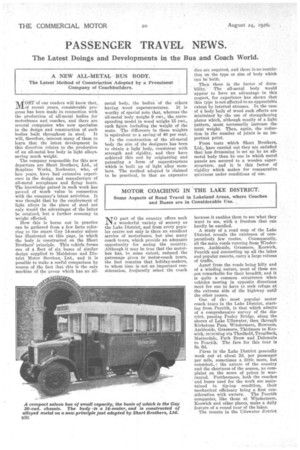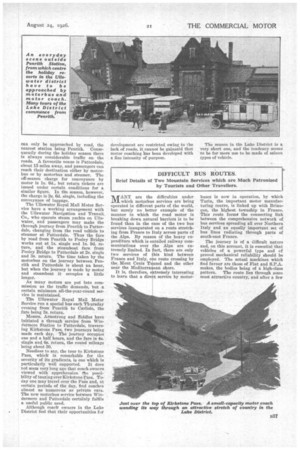PASSENGER TRAVEL NEWS.
Page 54

Page 55

If you've noticed an error in this article please click here to report it so we can fix it.
The Latest Doings and Developments in the Bus and Coach World.
1UTOST of our readers will know. that, 1.V_Lof recent years, considerable progresa has been made in, connection with the production of all-metal bodies for motorbuses and coaches, and there are several companies who now specialize in the design and construction of such
bodies built throughout in steel. It will, therefore, interest many of them to learn that the latest development in this direction relates to the production of an all-metal bus body in light alloys. saving much weight.
The company responsible for this new departure are Short Brothers, Ltd., of Seaplane Works, Rochester, who, of late years, have had extensive experience in the design and manufacture of all-metal aeroplanes and flying boats. The knowledge gained in such work has proved of much value in connection with the cOmpany's latest activities. It was thought that by the employment of light alloys in the place of steel not only would the advantages of the latter be retained, but a further economy in weight effected.
How this is borne out in practice can be gathered from a few facts referring to the smart Guy 14-seater saloon bus illustrated on this page, in which the body is constructed on the Short Brothers' principle. This vehicle forms one of a fleet of six buses of similar design supplied to Maidstone and District Motor Services, Ltd., and it is possible to make a useful comparison by reason of the fact that this is the only machine of the group which has an all metal body, the bodies of the others having wood superstructures. It is worthy of special note that, whereas the all-metal body weighs 9 cwt., the corresponding model in wood weighs 15 cwt., each figure including the weight of the seats. The difference in these weights is equivalent to a saving of 40 per cent.
In the construction of the all-metal body the aim of the designers has been to obtain a light body, consistent with strength and rigidity, and they have achieved this end by originating and patenting a form of superstructure which is built up of light alloy members. The method adopted is claimed to be practical, in that no expensive
NO part of the country offers such a wonderful variety of scenery as the Lake District, and from every popular centre not only is there an excellent service of motorbuses, but also many coach tours, which provide an adequate opportunity for seeing the country. Although it may be true that the motorbus has, to some extent, reduced the patronage given to motor-coach tours, the fact remains that holiday-makers, to whom time is not an important consideration, frequently select the coach dies are required, and there is no restriction on the type or size of body which can be built.
Then there is the factor of durability. ' The all-metal body Would appear to have an advantage in this respect, for experience has shown that this type is not affected to an appreciable extent by internal stresses. In the case of a body built of wood such effects are minimized by the use of strengthening plates which, although mostly of a light pattern, must necessarily increase the total weight Then, again, the reduction in .the number of joints is an important point.
From tests which Short Brothers, Ltd., have carried out they are satisfied that less drumming is set up by an allmetal body than by one in which metal panels are secured to a wooden superstructure, and it is this factor of rigidity which makes for comparative qu:etness under conditions of use.
because it enables them to see what they want to see, with a freedom that can hardly be excelled.
A study of a road map of the Lake District reveals the existence of comparatively few routes. Consequently, all the main roads running from Windermere, Ainbleside, Grasmere, Keswick, Penrith and connecting up all the lakes and popular resorts, carry a large volume of traffic.
Apart from the roads being hilly and of a winding nature, most of them are not remarkable for their breadth, and it is quite a common occurrence when vehicles moving in opposite directions meet for one to have to seek refuge at the extreme Side of the highway until the other passes. One of tin most popular motor coach tours in the Lake District, starting from Penrith, is that which admits of a comprehensive survey of the district, passing Pooley Bridge, along the shores of Lake Ullswater, then through Kirkstone Pass, Windermere, Bowness, Ambleside, Grasmere, Thirlmere to Keswick, returning via Threllceld, Troutbeck, Matterdale, Park Brow and Dalemain to Penrith. The fare for this tour is Ss. ficl.
Pares in the Lake District generally work out at about 2d. per passenger per mile, sometimes a little more, but consideri—T the nature of the country and the shortness of the season, no complaint on the score of prices is warranted. Furthermore, both the coaches ' and buses used for the work are maintained in tip-top condition, their mechanical efficiency being a first consideration with owners. The Penrith companies, like those at Windermere, Keswick and other places, make a daily feature of a round tour of the lakes.
The resorts in the 1.311swater district can only be approached by road, the nearest station being Penrith. Consequently during the holiday season there is always considerable traffic on the
roads. A favourite venue is Patterdale, about 15 miles away, and passengers can reach their destination either by motorbus or by motorbus and steamer. The off-season charge for conveyance by motor is is. 6d., but return tickets are issued under certain conditions for a similar figure. In the season, however, the charge is 2s. 6d. single, including the conveyance of luggage.
The Ullswater Royal Mail Motor Service have a working arrangement with the Ullswater Navigation and Transit_ Co., who operate steam yachts on Tillswater, and passengers may make the through journey from Penrith to Patterdale, changing from the road vehicle to steamer at Patterdale. Thus the fare by road from Penrith to Pooley Bridge works out at is. single and is. 9d. return, and the steamboat fare from Pooley Bridge to Patterdale at 2s. single and 3s. return. The time taken by the motorbus on the journey between Penrith and Patterdale is about an hour, but when the Journey is made by motor and steamboat it occupies a little longer.
As many motors are put into commission as the traffic demands, but a certain minimum all-the-year-round service is maintained.
The Ullswater Royal Mail Motor Service run a special bus each Thursday evening from Penrith to Carlisle, the fare being 3s. return.
Messrs. Armstrong and &ridles have initiated a through service from Windermere Station to Patterdale, traversing Kirkstone Pass, two journeys being made each day. The journey occupies one and a half hours, and the fare is 4s. single and 6s. return, the round mileage being about 30.
• Needless to say, the tour to Kirkstone Pass, which is remarkable for the severity of its gradients, is one which is
particularly well supported. It does not seem very long ago that coach owners viewed with apprehension te possibility of touring over Kirkstone pass. Today one may travel over the Pass and, at certain periods of the clay, find coaches almost as numerous as private cars. The new motorbus service between Windermere and Patterdale certainly fulfils a useful public need.
Although coach owners in the Lake • District feel that their opportunities for development are restricted owing to Ole The season in the Lake District is a lack of roads, it cannot be gainsaid that very short one, and the tendency seems motor coaching has been developed with to be for more use to be made of saloon a fine intensity of purpose. types of vehicle.




































































































